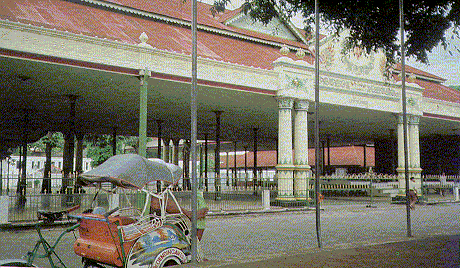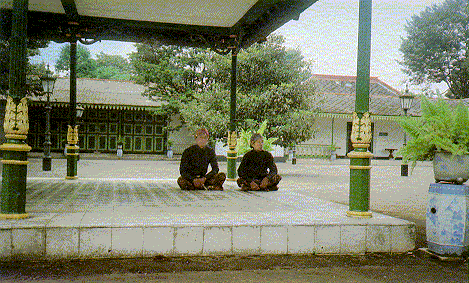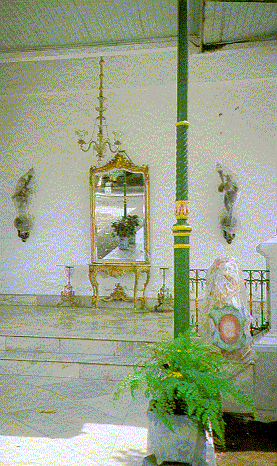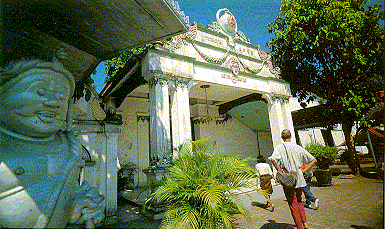
Outside the palace with becak.
A Vist to the Kraton Yogyakarta
by Claire-Marie Hefner

A Vist to the Kraton Yogyakarta
by Claire-Marie Hefner
Yogyakarta is the site of the simple but elegant
kraton or palace of Yogyakarta. The palace is currently the home
of the 10th sultan, Hamengku Buwana X, who lives there with his wife and
five daughters. His name, Hamengku Buwana, means ďthe nail or axis
of the earth.Ē His father, the 9th sultan, is probably the most famous
of the Yogyanese sultans. He had eight wives and something like 88
children. Because the present sultan only has daughters, probably
his brother or his brotherís oldest son will become the next sultan.
The ninth sultan is the most famous because he was active in the struggle
for Indonesian independence around the time of World War II. His
son, the tenth sultan, is still respected by the people but holds little
power. He is really more of an icon than a political leader.
Still, when there were some recent political demonstrations in Indonesia
and some cities had neighborhoods that were burned and stores that were
looted, people believe nothing happened in Yogya because of the sultanís
leadership and magical power.
The kraton is made up of a number of small,
free-standing, buildings called pendopo. Pendopo are open buildings
with no walls, only a high roof and cool gray tile floors. They are
decorated with giant painted Chinese vases with palms and other plants
growing in them, imported Italian crystal chandeliers, and porcelin plates
from the Netherlands. Most of these things were given to the different
sultans by foreign heads of state.
The different pendopo have different functions. One especially
large one is used for parties and reception for diplomats and foreign visitors.
Hillary Clinton was even greeted there a few years ago.
Another pendopo is used for holding royal
dances. The sultan had his own special dance group made up of young
beautiful girls who were trained to perform a traditional royal dance
which was only done for him called the bedoyo dance. This dance used
to be secret and only the royal dancers could do it, but now that is not
the case. You can even watch the bedoyo dance performed at the palace
nowadays on special evenings.
There were other pendopo which have been turned
into little museums. There is one that has lots of palanquins, little
houses with seats inside that lay on two long poles which men would carry
on their shoulders. There was one open one that the sultan would
ride in to see the royal realm and for a little fresh air. There
was another one that the royal newlyweds would ride in through the streets
after the marriage ceremony. One really interesting thing you can
see in the same museum is a large cage with no bottom which, when the baby
sultan was about 6 months old, he would be placed under. Attendants
would put make-up and a mirror, a pencil and paper, and some money and
jewelry in the cage with the baby. Javanese believe if the baby shows
interest in the make-up and mirror then he would grow up to be handsome;
if he picks the pencil and paper, he will be smart, and if he picks the
money and jewelry, he will grow up to be rich. Our tour guide said
that the 9th sultan had picked up everything! So he grew up to be
not only handsome, but also smart and rich.
The recent sultan built a small museum specially
for his father, Hamengku Buwono the 9th. In it there are pictures
of the 9th sultan as a boy scout, playing soccer (a very popular sport
here), getting awards, and some other important events that he was involved
in. In the very center of the museum is a really large painting of
Hamengku Buwono the 9th in his royal finery. He has a special dagger
which is supposed to have magical power (called a keris) tucked into the
side of his waist sash and whatís really weird is that he has decorations
on the top of his ears that look like pointed leaves. The tour guide
explained that these ear decorations symbolize wisdom. They make
him look like Dr. Spock of Star Trek!
Another part of the palace is filled with
large jugs that used to be used for storing wine for guests. But
the current sultan, who is a more serious Muslim, only drinks wine on special
occasions and actually prefers Coca-Cola. There are also presents
on display, mostly tea sets, from famous leaders of the past. There
is even a set from Napoleon himself! There were many others from
Holland, France, and China, some with photos of members of the royal family
on them.
Everything on the palace grounds is symbolic,
even the trees and flowers. My favorites are these special royal
symbols in code called condrosengkolo. In a condrosengkolo each symbol
is given a number and the numbers are read backwards to find an important
date. There is a condrosengkolo carved on a gate in front of one
of the pendopo which tells when the building was rebuilt. On the
top of the gatre is a carving of two serpents with crowns on their heads.
In the center of the two serpents there is a giantís head. The head
has a leech in itís hair. The leech=3, the giant=5, the serpent=8,
and the crown on the serpentís head= 1. When you read it backwards,
you get 1853, the date when the building was renovated.
I really enjoyed visiting the palace and hope
to go back again. It would take many visits to discover all the different
symbols and understand their meanings. When I was there I kept thinking
about some European palaces like Versailles in France. I love Versailles
because it is so dazzling, with high ceilings and gold and jewels and mirrors
and polished marble. Versailles is really awesome, but it lacks the
simple, calm, elegance of the kraton. They are really two very different
ways to be royal.

Two Abdi Dalem, palace servants, in main court yard.

Sultan's office.

The main entrance to the Kraton.